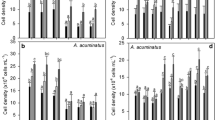Abstract
In order to explore the growth inhibition and physiological responses of unicellular and colonial Microcystis aeruginosa during coexistence with Acorus calamus, algal densities, chlorophyll a contents, exopolysaccharide (EPS) concentrations, malondialdehyde (MDA) contents, catalase (CAT) activities, and peroxidase (POD) activities of the two algae strains were analyzed. Although the unicellular and colonial strains of M. aeruginosa were both inhibited by A. calamus, unicellular algae were more sensitive than the colonial algae. The measurement results for EPS, MDA, CAT, and POD showed that unicellular M. aeruginosa had higher levels of stress related damage than colonial strains when they were exposed to the same density of A. calamus, and the cellular defense system of colonial M. aeruginosa was stronger than that of unicellular M. aeruginosa. Natural blooms of Microcystis are typically composed of colonial forms of M. aeruginosa, therefore future efforts to control such blooms, possibly through the development of new algicides, should focus on the unique characteristics of colonial M. aeruginosa strains.




Similar content being viewed by others
References
Codd G-A, Morrison L-F, Metcalf J-S (2005) Cyanobacterial toxins: risk management for health protection. Toxicol Appl Pharmacol 203:264–272
Dias M-A, Costa M-M (1983) Effect of low salt concentrations on nitrate reductase and peroxidase of sugar beet leaves. J Experiment Bot 34:537–543
Habib K, Manikar N, Zutshi S, Fatma T (2011) Biochemical effect of carbaryl on oxidative stress, antioxidant enzymes and osmolytes of cyanobacterium Calothrix brevissima. Bull Environ Contam Toxicol 87(6):615–620
Hellebust J, Craigie J (eds) (1978) Handbook of phycological methods. Physiological and biochemical methods. Cambridge University, Cambridge
Hong Y, Hu H-Y, Xie X, Sakoda A, Sagehashi M, Li F-M (2009) Gramine-induced growth inhibition, oxidative damage and antioxidant responses in freshwater cyanobacterium Microcystis aeruginosa. Aquat Toxicol 91:262–269
Inskeep W-P, Bloom P-R (1985) Extinction coefficients of chlorophyll a and b in N, N-dimethylformamide and 80% acetone. Plant Physiol 77:483–485
Körner S, Nicklisch A (2002) Allelopathic growth inhibition of selected phytoplankton species by submerged macrophytes. J Phycol 38:862–871
Latifi A, Ruiz M, Zhang C-C (2009) Oxidative stress in cyanobacteria. FEMS Microbiol Rev 33:258–278
Pajdak-Stos A, Fialkowska E, Fyda J (2001) Phormidium autumnale (Cyanobacteria) defense against three ciliate grazer species. Aquat Microb Ecol 23:237–244
Park M-H, Chung I-M, Ahmad A, Kim B-H, Hwang S-J (2009) Growth inhibition of unicellular and colonial Microcystis strains (Cyanophyceae) by compounds isolated from rice (Oryza sativa) hulls. Aquat Bot 90:309–314
Qian H-F, Xu X-Y, Fu Z-W (2009) Allelochemical stress causes oxidative damage and inhibition of photosynthesis in Chlorella vulgaris. Chemosphere 75:368–375
Rao M-V, Paliyath G, Ormrod D-P (1996) Ultraviolet-B and ozone-induced biochemical changes in antioxidant enzymes of Arabidopsis thaliana. Plant Physiol 110:125–136
Sabatini S-E, Brena B-M, Luquet C-M, Julián M-S, Pirez M, de Molina M-D-C-R (2011) Microcystin accumulation and antioxidant responses in the freshwater clam Diplodon chilensis patagonicus upon subchronic exposure to toxic Microcystis aeruginosa. Ecotoxicol Environ Saf 74:1188–1194
Shen H, Song L-R (2007) Comparative studies on physiological responses to phosphorus in two phenotypes of bloom-forming Microcystis. Hydrobiologia 592:475–486
Shiu C-T, Lee T-M (2005) Ultraviolet-B-induced oxidative stress and responses of the ascorbate-glutathione cycle in a marine macroalga Ulva fasciata. J Exp Bot 56:2851–2865
Staats N, De Winder B, Stal L-J, Mur L (1999) Isolation and characterization of extracellular polysaccharides from the epipelic diatoms Cylindrotheca closterium and Navicula salinarum. Eur J Phycol 34:161–169
State Environmental Protection Administration (SEPA) of China (2002) Monitor and analysis method of water and wastewater. Chinese Environmental Science Publication House, Beijing 246 pp
Zhang W-H, Hu G-J, He W, Zhou L-F, Wu X-G, DING H-J (2009) Allelopathic effects of emergent macrophyte, Acorus calamus L. on Microcystis aeruginosa Kuetzing and Chlorella pyrenoidosa Chick. Allelopathy J 24(1):157–168
Zhang S-H, Sun P-S, Ge F-J, Wu Z-B (2011a) Different sensitivities of Selenastrum capricornutum and toxic strain Microcystis aeruginosa to exudates from two Potamogeton species. Polish J Environ Stud 20(1):1359–1366
Zhang S-L, Zhang B, Dai W, Zhang X-M, Zhang X-L (2011b) Oxidative damage and antioxidant responses in Microcystis aeruginosa exposed to the allelochemical berberine isolated from golden thread. J Plant Physiol 168:639–643
Zhang T-T, Wang L-L, He Z-X, Zhang D-A (2011c) Growth inhibition and biochemical changes of cyanobacteria induced by emergent macrophyte Thalia dealbata roots. Biochem Syst Ecol 39:88–95
Zhao J, He XM, Sun PS, Zhang S-H (2012) Different sensitivities of unicellular and colonial Microcystis strains (Cyanophyceae) to six emergent macrophytes. Pol J Environ Stud 22(5):1539–1546
Zhu J-Y, Liu B-Y, Wang J, Gao Y-N, Wu Z-B (2010) Study on the mechanism of allelopathic influence on cyanobacteria and chlorophytes by submerged macrophyte (Myriophyllum spicatum) and its secretion. Aquat Toxicol 98:196–203
Acknowledgments
This work was supported by grants from the National Science Fund of China (51008265, 51468066), the Science and Technology Program of Yunnan Province, China (2014FB105), and the Program for Science Research of the Yunnan Educational Committee (2013Y352).
Author information
Authors and Affiliations
Corresponding author
Rights and permissions
About this article
Cite this article
Zhang, SH., Chang, JJ., Cao, JY. et al. Comparative Studies on Growth and Physiological Responses of Unicellular and Colonial Microcystis aeruginosa to Acorus calamus . Bull Environ Contam Toxicol 94, 225–231 (2015). https://doi.org/10.1007/s00128-014-1424-1
Received:
Accepted:
Published:
Issue Date:
DOI: https://doi.org/10.1007/s00128-014-1424-1




